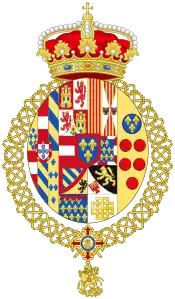Prince Ferdinand Pius, Duke of Castro
Prince Ferdinand Pius (Ferdinando Pio Maria), Duke of Castro (25 July 1869, Rome – 7 January 1960, Lindau), was head of the House of Bourbon-Two Sicilies and pretender to the throne of the extinct Kingdom of the Two Sicilies from 1934 to 1960.
| Prince Ferdinand Pius | |||||
|---|---|---|---|---|---|
| Duke of Castro, Duke of Calabria | |||||
 | |||||
| Head of the House of Bourbon-Two Sicilies | |||||
| Tenure | 26 May 1934 – 7 January 1960 | ||||
| Predecessor | Prince Alfonso | ||||
| Successor | Disputed: Prince Ranieri (brother) Infante Alfonso (nephew) | ||||
| Born | 25 July 1869 Rome, Papal States | ||||
| Died | 7 January 1960 (aged 90) Lindau, Bavaria, Germany | ||||
| Burial | Filialkirche St. Peter und Paul, Rieden, Swabia, Germany | ||||
| Spouse | Princess Maria Ludwiga Theresia of Bavaria | ||||
| Issue | Princess Maria Antonietta Princess Maria Cristina Prince Ruggiero Maria, Duke of Noto Princess Barbara Maria Princess Lucia, Duchess of Genoa Princess Urraca Maria | ||||
| |||||
| House | Bourbon-Two Sicilies | ||||
| Father | Prince Alfonso, Count of Caserta | ||||
| Mother | Princess Maria Antonietta of Bourbon-Two Sicilies | ||||
| Religion | Roman Catholicism | ||||
Family
Ferdinand was the eldest child of Prince Alfonso, Count of Caserta and his wife Princess Maria Antonietta of Bourbon-Two Sicilies. He was a grandson of Ferdinand II of the Two Sicilies and an older brother of Prince Carlos of Bourbon-Two Sicilies, Maria Immaculata, Princess Johann Georg of Saxony, Maria Cristina, Archduchess Peter Ferdinand of Austria, Maria di Grazia, Princess Imperial of Brazil, Prince Ranieri, Duke of Castro, Prince Philip of Bourbon-Two Sicilies, and Prince Gabriel of Bourbon-Two Sicilies.
Marriage
Ferdinand married Princess Maria Ludwiga Theresia of Bavaria, daughter of King Ludwig III of Bavaria on 31 May 1897. They had six children:[1][2]
- Princess Maria Antonietta (1898–1957)
- Princess Maria Cristina (1899–1985), married in 1948 to Manuel Sotomayor-Luna, Vice President of Ecuador
- Prince Ruggiero Maria, Duke of Noto (1901–1914)
- Princess Barbara Maria Antonietta Luitpolda (1902–1927), married in 1922 to Count Franz Xaver zu Stolberg-Wernigerode
- Princess Lucia Maria Raniera (1908–2001), married in 1938 to Prince Eugenio of Savoy, Duke of Ancona
- Princess Urraca Maria Isabella Carolina Aldegonda (1913–1999)
Ferdinand and Maria lived for many years at Villa Amsee, Lindau. It was there that he died in 1960.
Disputed succession
Following Ferdinand's death, the headship of the House of Bourbon-Two Sicilies was claimed by both his nephew Infante Alfonso, Duke of Calabria, and his brother Prince Ranieri, Duke of Castro, and remains disputed between their descendants. The basis of Alfonso’s claim was that his late father, Prince Carlos of Bourbon-Two Sicilies (1870–1949), had been Ferdinand's next oldest brother.[3] But Henri, Count of Paris, upheld the claim of Ferdinand's younger brother, Prince Ranieri, Duke of Castro (1883–1973), contending that Carlos had renounced his rights of succession for himself and his descendants in 1901 when he married the Spanish heiress presumptive María de las Mercedes, Princess of Asturias. The Count of Paris was well aware that his own claim to the French throne depended on the validity of the renunciation in 1713 of Philip V of Spain, in favor of the junior House of Orléans.[3]
In 1900, Prince Carlos had executed the Act of Cannes, in anticipation of his marriage to María de las Mercedes, and in 1901 he became a Spanish subject and accepted the title of Infante. The position of Ranieri was that by so doing Carlos had renounced any claim to the throne of the Two Sicilies. But Alfonso had a different interpretation, which was that the Act of Cannes would have taken effect only if Mercedes and Carlos had succeeded to the Spanish throne. He also argued that the Act of Cannes was invalid under the succession rules of the house of Two Sicilies. The dispute remains unresolved.[4]
Honours
- Grand Master of the Sacred Military Constantinian Order of Saint George
- Grand Master of the Order of Saint Januarius
- Grand Master of the Order of Saint Ferdinand and of Merit
- Grand Master of the Royal Order of Francis I
- Grand Master of the Order of Saint George and Reunion
- Knight of the Spanish Order of the Golden Fleece
- Knight of the Order of Saint Hubert of Bavaria
- Knight of the Supreme Order of the Most Holy Annunciation
- Bailiff Grand Cross of Honor and Devotion of the Sovereign Military Order of Malta
- Knight Grand Cross of the Order of Charles III
Arms
- Heraldry of Prince Ferdinand Pius
.svg.png.webp) Prince Ferdinand's arms
Prince Ferdinand's arms
Until 1894 Prince Ferdinand's arms as titular heir to the throne
Prince Ferdinand's arms as titular heir to the throne
1894-1934 Prince Ferdinand's arms as head of the Royal House
Prince Ferdinand's arms as head of the Royal House
1934-1960
Ancestry
| Ancestors of Prince Ferdinand Pius, Duke of Castro |
|---|
References
- "Bourbon-Two Sicilies Royal Family". Archived from the original on March 17, 2006. Retrieved 2006-03-17.
- "GENEALOGY OF THE HOUSE OF BOURBON - TWO SICILIES - the Royal House of Bourbon - Two Sicilies". Archived from the original on 2008-07-05. Retrieved 2010-07-19..
- Philippe de Montjouvent, Le Comte de Paris et sa Descendance (Charenton: Editions du Chaney, 1998 ISBN 2-913211-00-3), pp. 251-261, 264-265, 270-272
- Olga S. Opfell, Royalty Who Wait: The 21 Heads of Formerly Regnant Houses of Europe (Jefferson, North Carolina: McFarland & Company, 2001), pp. 37–38